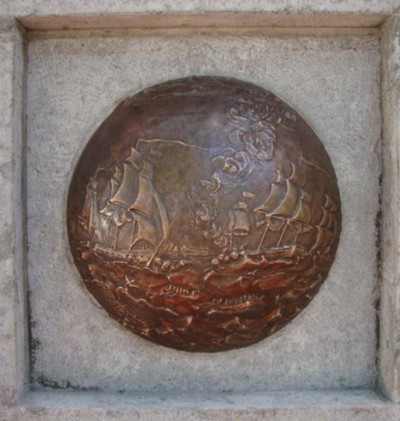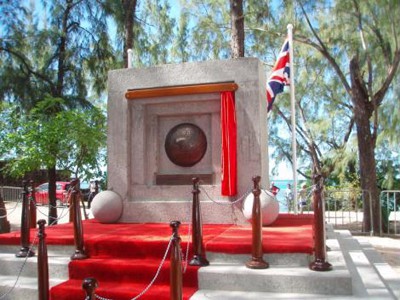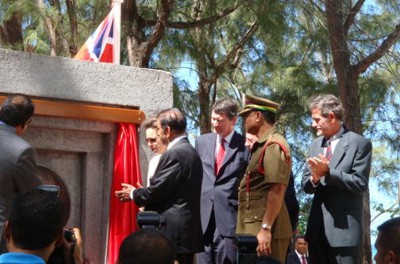Introduction
Thursday 2nd December 2010
In the presence of HRH Princess Anne
The speech
Your Royal Highness,
President of the Republic,
Distinguished Guests,
We are at the place where two hundred years ago, some 12,000 British and Indian soldiers and sailors landed, to fight the French and attempt to capture the Ile de France. This is certainly a great turning point in our history and I will describe some of the events of that time.
But let us return to some decades before the 1810 British landing for some perspective on the events of 1810.
Ile de France had long been involved in conflict with Britain. Local men had served in the conflicts elsewhere as part of the French forces. The successes of Suffren in India, Lafayette in America, and Surcouf in local waters, owe in part to men from Ile de France. So when the Revolutionary wars began between France and most of its neighbours, by extension war was carried here, to the Indian Ocean islands. The rise of Bonaparte was stemmed on the seas after Trafalgar in 1805, although in the Indian Ocean the French were giving the British a real beating.
The continued heavy losses by British Indiamen involved in the immensely wealthy commerce between India and Britain, forced Britain to consider capturing Ile de France – the main naval base of the Indian Ocean. The defences of the island were sparse and General Decaen knew that his meager forces had little chance of withstanding any serious enemy attack if a successful landing was made. But the British did not realize how easy it might be to take Ile de France, despite several reliable intelligence reports, all of which indicated that a few thousand trained troops landed in a bay on the west coast, would take the island.
Finally the British plans gelled – Lord Minto, governor-general of India together with Vice-Admiral Albemarle Bertie, Commander- in-Chief at the Cape, concurred that taking Rodrigues would provide an assembly point from which to muster an invasion of Ile de France. Rodrigues was thus taken with no fuss in August 1809, against a relaxed band of the three resident Frenchmen with some seventy slaves. Last year our President inaugurated a monument commemorating the bicentenary of the capture of Rodrigues, at Baie aux Anglais in Rodrigues.
The Seychelles archipelago was similar easy prey as Rodrigues. However, Ile Bonaparte (La Réunion) was more difficult and the conquest bloody, but finally it was captured in July 1810. For the conquest of Ile de France, a complex network of co-operation was established between the Indian Army, troops at the Cape, the Royal Navy and the East India Company.
An impressive invasion flotilla of seventy vessels – twenty warships and fifty transport ships – arrived from Rodrigues, India and the Cape, and moored between Gunners Coin and the mainland coast in the morning of 29th November 1810.
Incredibly, a couple of weeks prior to the invasion fleet arrival, a reconnaissance party of British engineers with sounding lines, were captured in the lagoon, but the General Decaen did not believe the threat of a landing in these parts was likely. Similarly, after the capture of Rodrigues, Decaen did not heed advice to seek and destroy the British fleets at anchor there. In both cases, if he had taken preventative action, history might have been different and Mauritius would be a very different place today.
Anyway, the landing parties on that fateful 29th November, were very efficient and very lucky. Efficient because more than 4,000 men were disembarked between ten in the morning and two in the afternoon on these beaches before us. And lucky, because there was no wind and the sea was flat. Over the following days, the rest of the 8,000 men and equipment were offloaded in small boats under tight control; heat and thirst were their major problems, because from here, down the Chemin de Vingt-pieds, and thence down to Moulins à Poudre where a camp was set up, there were no rivers and it was the height of the dry season.
The only defences in the region were at Pointe aux Canonniers and Fort Malartic, both of which were rapidly captured; their ruins can still be seen. While the British and Indian troops marched on the French, the ships massed off various localities along the west coast – from Tamarin, Grande Riviere, Baie du Tombeau and Baie aux Tortues. General Decaen deployed his 3,500 ill-sorted soldiers, militia and volunteers, to defend the Port, and the approaches to the capital. The main Pamplemousses road, Montagne Longue, then Batterie Dumas (where Plaine Verte is today), were manned and defended, but the French troops were hopelessly outnumbered. At most times, the troops in the lines were outnumbered by ten to one. General Decaen inspected the British forces on the second day and received a gunshot in the foot and through his hat, but he saw enough to convince him of the futility of fighting. Nevertheless, the French attacked the advancing British lines, and incurred quite heavy losses on them, with a number of officers killed. The Sepoys attacked Montagne Longue and displaced the French and the coastal batteries were taken by the British one after the other.
When, on the third day after the British landing, Decaen received reports of vessels approaching Grande Riviere and off the Port, he decided to negotiate for peace.
On Sunday the 2nd December 1810, the British forces spotted the white flag of truce raised by the French at the capital. Negotiation lasted all day and evening, and in the early hours of Monday morning, terms were agreed and Captain Duperré and General Vandermaesen signed the accord with their British counterparts, Commodore Rowley and General Warde. The Governor-General Charles Decaen ratified the capitulation shortly afterwards. Ile de France was no more and British Mauritius was born.
Today, two hundred years later, we stand before the first monument in Mauritius to commemorate this great turning point, in a republic which has been independent forty-two years, we remember those few hundred killed and wounded in the conflict. Some of our ancestors defended the island, others actively supported the British and all the free inhabitants who remained in Mauritius, signed an oath of Allegiance to King George III one month after the capture. On a personal note, I am pleased that Jean-Claude Maingard helped with monument, as his ancestor commanded the guns which fired at the British from Batterie Dumas. And my Historical Society colleague Raymond d'Unienville's ancestor who became a trusted colleague of Governor Farquhar. My ancestors too, like many others, fought against, then later collaborated with the British.
While most of the soldiers who had disembarked that 29th November had already re-embarked and left Mauritian waters for India and the Cape within the month, some stayed on in the 3,500-strong British garrison. Indeed, there was a marriage in February 1811 between a twenty-five year old soldier of the 22nd Cheshire regiment and a grand-daughter of Nicolas Céré, a famous figure from the French period, proof of the links which were to develop between the British and the local inhabitants. Other families were founded, like that of Sergeant John Newton of the 22nd Regt, who's grandson Sir William Newton has his statue in the Place d'Armes in Port Louis. The Indian troops all returned to India, where the Bengal Government struck 2,200 medals with which they decorated their gallant sepoy soldiers who participated in the campaign – the governments of Bombay and Madras declined to do the same; today these are collectors' pieces.
The aftermath of the capitulation is really fascinating because this is where the development of our culturally-rich and complex society really flourishes. I will not elaborate on this, but must mention some momentous events in the decades which followed:
1. The treaty of Paris in 1814 which divided up the captured islands, giving Bourbon back to France. Some of today's regional territorial disputes are rooted in this Treaty.
2. The banning of the slave trade, followed by abolition of slavery – the end to one of humanity's terrible inhumanities. What did the poor slaves think when they heard of the British landing? Liberation? They were sadly deceived and it was only twenty-four years later that British public opinion and government managed this.
3. The start of the great organized immigration of labourers from India. Despite the frequently difficult work conditions of these labourers, through dint of determination, democracy and equal opportunity was achieved in the following century.
The first British Governor, Sir Robert Townshend Farquhar, who administered the islands immediately after the conquest, for twelve years, also deserves a mention. He put into practice the remarkably tolerant terms of the Capitulation. A fluent French speaker, he courted the French inhabitants and fluidly managed to effect the change from Ile de France to Mauritius. It is arguably his determination to create stability and prosperity through intelligent compromise, which served as his legacy, assisting Mauritius to progress during the 19th century.
Some consequences of the British landing are our bilingual or multilingual condition, our system of law which is a combination of Napoleonic code and common law – our education system and medium of education which is English. Even our demography composed of the descendants of Indians who came to Mauritius through the British indentured labour system offering opportunities elsewhere in the empire, together with the descendants of those French inhabitants and slaves brought mainly from Africa and Madagascar, is an important consequence of the British landing.
What started as a military and naval operation, we see today through a perspective of two hundred years, has created a wonderful and vibrant mix of people and heritage, in a modern, dynamic and democratic Mauritius. This monument before us will remind us of this legacy.
I thank you for your attention and I now invite Your Royal Highness and the President of the Republic, to come to the monument for the unveiling.
Thank you.
Philippe la Hausse de Lalouvière is a biologist who manages agro-industrial operations on Mauritius, currently CEO of Les Moulins de la Concorde Ltée. He has restored forts, set up museums and published seven books on heritage. He was first president of the National Heritage Fund which government established to manage the cultural heritage of Mauritius, he is past-president of the Société de l'Histoire de l'Ile Maurice, president of Friends of the Environment and Treasurer-General of ICOMOS which is responsible for UNESCO World Heritage. He is a trail endurance runner currently leading the national league in the veteran category. (phillah@intnet.mu)
Monument inscription
 The British invasion of the Isle of France started hereabouts where the landing took place on 29 November and ended on the outskirts of Port Napoléon (Port Louis) where the French capitulated on 3 December 1810
The British invasion of the Isle of France started hereabouts where the landing took place on 29 November and ended on the outskirts of Port Napoléon (Port Louis) where the French capitulated on 3 December 1810
This monument was unveiled by HRH The Princess Royal KG KT GCVO QSO in the presence of Sir Anerood Jugnauth PC KCMG QC the President of the Republic of Mauritius, on 2 December 2010
Monument
 The monument with its bronze domes was designed by Zsuzsanna Zemok, who many people know as she has designed and built other wonderful monuments in Mauritius and in Hungary, including a Paul & Virginie in Pamplemousses, a Madonna & child at Trou d'Eau Douce, the Phoenix at Pont Fer and the memorial to Captain Matthew Flinders at Baie du Cap.
The monument with its bronze domes was designed by Zsuzsanna Zemok, who many people know as she has designed and built other wonderful monuments in Mauritius and in Hungary, including a Paul & Virginie in Pamplemousses, a Madonna & child at Trou d'Eau Douce, the Phoenix at Pont Fer and the memorial to Captain Matthew Flinders at Baie du Cap.
The monument was built by JN Enterprises and we thank Jocelyn Neeladoo for his fine work, with the guidance of Laszlo Tiborcz of TransInvest, and General Construction's Edgar Jullienne, Nanno Adam and Jean-Claude Maingard.
Société de l'Histoire
The Society's objective is to make the history of Mauritius as widely known as possible, through research, publications and projects. To this end it has constructed more than a dozen monuments in Mauritius, which provide anchors for the memory of the past to persist in the present and future generations. History is important in the construction of modern Mauritius, especially history shared with other nations, and events like this momentous invasion seem distant for most Mauritians, but in fact the sequels of it remain all around us.


